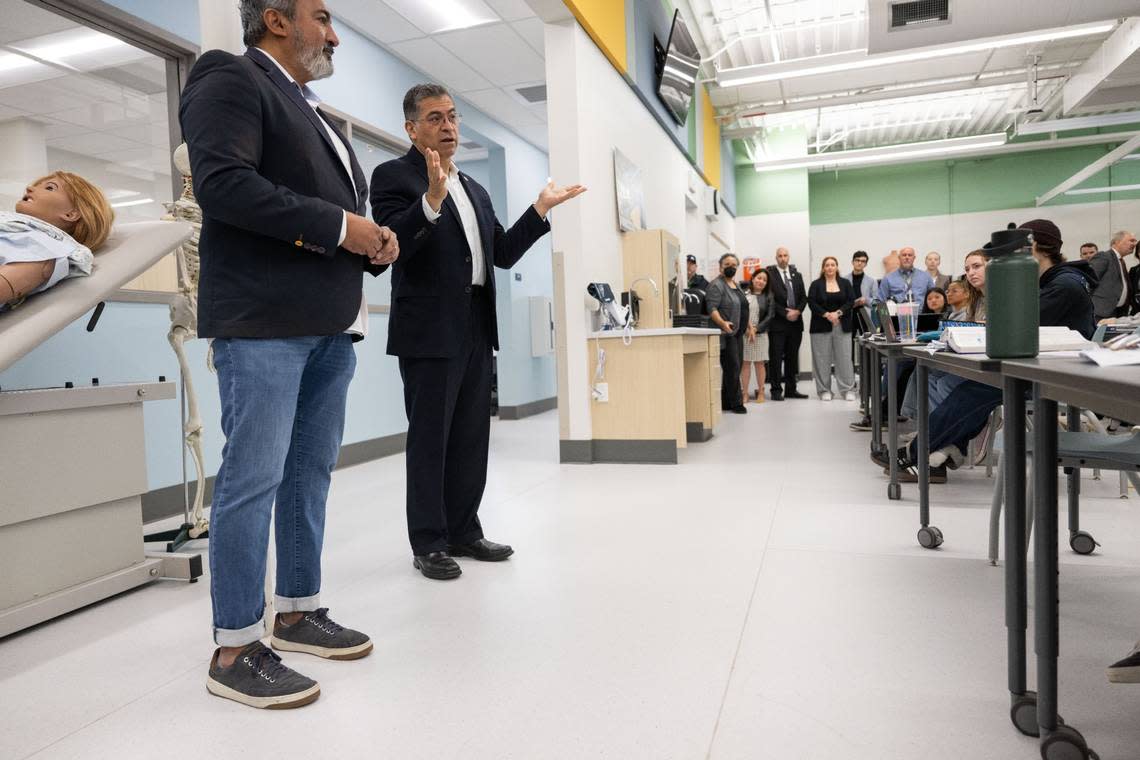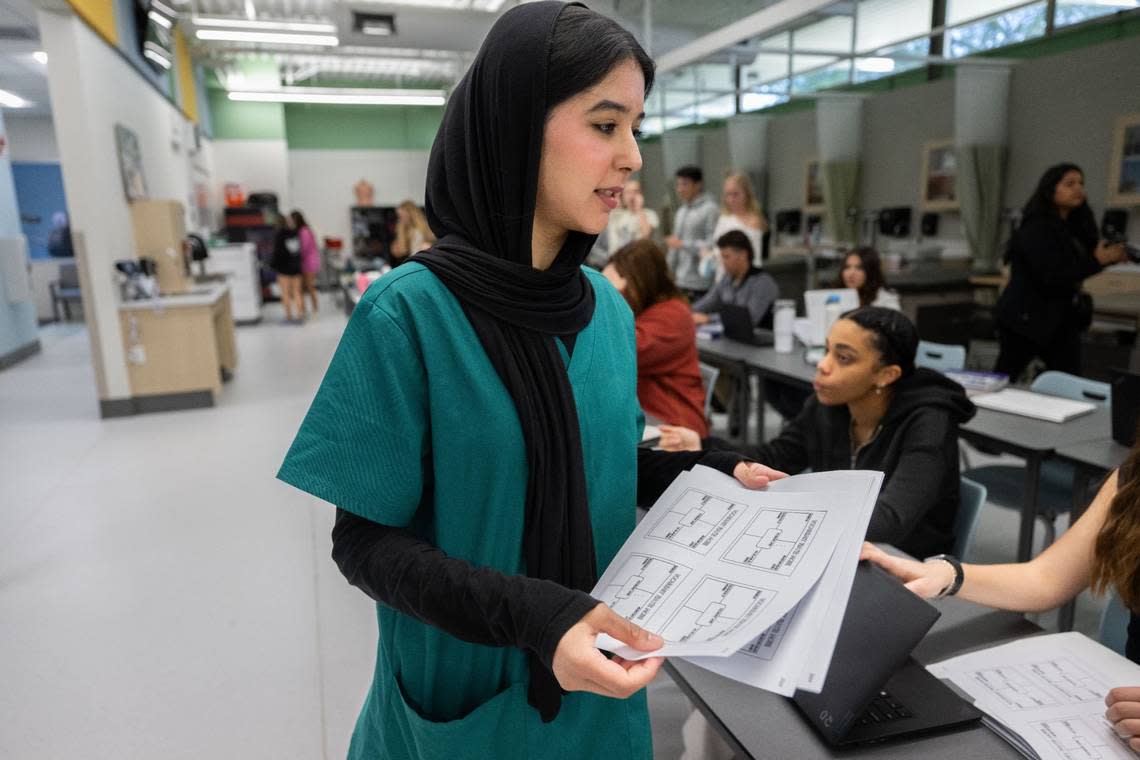Why one Sacramento high school has HHS chief confident in the future of health care workforce
At Rio Americano High School, dozens of students like sophomores Liliana Lettini and Derek Gale are training to get certified as medical students upon graduation.
It’s programs like these that U.S. Health and Human Services Secretary Xavier Becerra said are preparing young people for jobs in health care.
“We want in if you’re going to start giving young folks, before they graduate from high school, a sense of leadership, a sense of belonging, a sense of worth and professionalism,” he said. “We want it because we know that, in America, we’re lacking all those young professionals.”
Becerra, a Sacramento native and C.K. McClatchy High School graduate, held a listening session alongside U.S. Rep. Ami Bera, D-Elk Grove, at Rio Americano in Arden Arcade. While most of the students said they plan to go on to become physicians, Bera told the students he worked to support himself as he earned his medical degree. Students can earn $25 an hour or more as medical assistants, he said, as they continue along the educational pathway needed to attain the career they want.
After their Monday meeting at the high school, Bera and Becerra said they heard a refrain that is common nationwide: Many students want to go into nursing or become a physician, but there just aren’t enough slots open at colleges for them. The colleges, in turn, say they can’t find enough health systems to provide the training hours in hospitals, clinics or other similar settings that students require to graduate.
Becerra said that colleges have told them that the crucial element here is that they have found it virtually impossible to compete for instructors.
“We’d like to make it so that perhaps we can subsidize a university or community college holding onto that professional faculty member,” Becerra said.

A pathway for nurses to be educators
Health care companies also need more nurses in the field willing to serve as educators, or preceptors, when students arrive in clinical settings for training. Despite the relationships that educators build with students in college, it can be difficult to find enough nurses willing to take on the added responsibility and workload of this commitment.
Michael Korpiel, the Sacramento market president for Dignity Health, said that his company works with every one of the universities in the area to get as many students in as possible but there’s certainly a need for more preceptors.
He highlighted the work that Carmichael’s Mercy San Juan Hospital has done with Los Rios Community College District to ensure there are enough external internship, or externship, spaces for students training to become licensed vocational nurses, who play a key role in caring for the nation’s growing elderly population.
“We have to be creative and explore new things in order to train more nurses,” he said.
In some areas of California, the number of nurse-educators is not the only challenge. The latest survey of nursing program administrators showed that 92 out of 152, particularly those at community college and state university programs, say in annual surveys that they are being denied access to clinical placements for their nursing students even as for-profit colleges are securing additional slots.
In the meantime, they say, nursing programs at for-profit colleges are making requests to the California Board of Registered Nursing to expand enrollment numbers because they have secured more than enough clinical placements for the added students.

State aims to level playing field in nurse training
The dearth of clinical slots raised enough concern that state Sen. Dave Cortese, D-San Jose, recently introduced new legislation, Senate Bill 1015, to give the nursing board greater authority to monitor, investigate and enforce the statutory prohibition against approved nursing schools from paying a clinical facility in exchange for clinical placements.
Regardless of what is causing the shortage of medical assistants, nurses, x-ray technicians and other health care workers, Bera said, representatives of major Sacramento-area health systems have come to him seeking assistance in solving it.
Both rural and low-income communities have the greatest need for these workers, Becerra and Bera said, and the best shot at overcoming labor shortages in those areas is to educate young people who grew up in them.
HHS Health Workforce Initiative is focused on federal investments to support individuals across health workforce disciplines. It includes a coordinated effort to identify opportunities to improve health workforce recruitment, retention, and career advancement.
How HHS has worked to increase number of health care workers
Becerra said that HHS has been focusing on ways to invest federal dollars to support individuals dedicated to improving the nation’s health and well-being, including physicians, nurses, dentists, behavioral health care providers, community health workers and peer support specialists.
The agency has helped many young people pay for college, he said, but it is also working to identify opportunities to improve health workforce recruitment, retention and career advancement.
Roughly 18,000 doctors are practicing now who received either scholarships from a federal agency or some sort of loan forgiveness, he said, and in exchange, many have agreed to practice for a set number of years in areas of the nation’s greatest need.
While the nation can feel good about this investment, he said, the Association of American Medical Colleges has estimated that the United States will face a shortage of up to 86,000 physicians by 2036. The U.S. also faces a shortfall of roughly 60,000 workers in the dental field, he said.
“When you see an opportunity to support a program that is bringing young folks in quickly, in good numbers, you want to be there,” Becerra said, referring to Rio Americano’s medical assistant program.
Roughly 95% of students in the high school’s medical assistant program have passed the certified medical assistant exam. That’s no small feat when you consider that, from July 2021 to July 2022, only 58% of the 9,047 people who sat for the exam scored high enough to pass.
The idea is to create a pathway for young people like the students at Rio Americano where they can get college credit in high school, get their foot in the door with their medical assistant certification and use that job to help support themselves as they pursue education and training to move into better-paying fields in health care.
